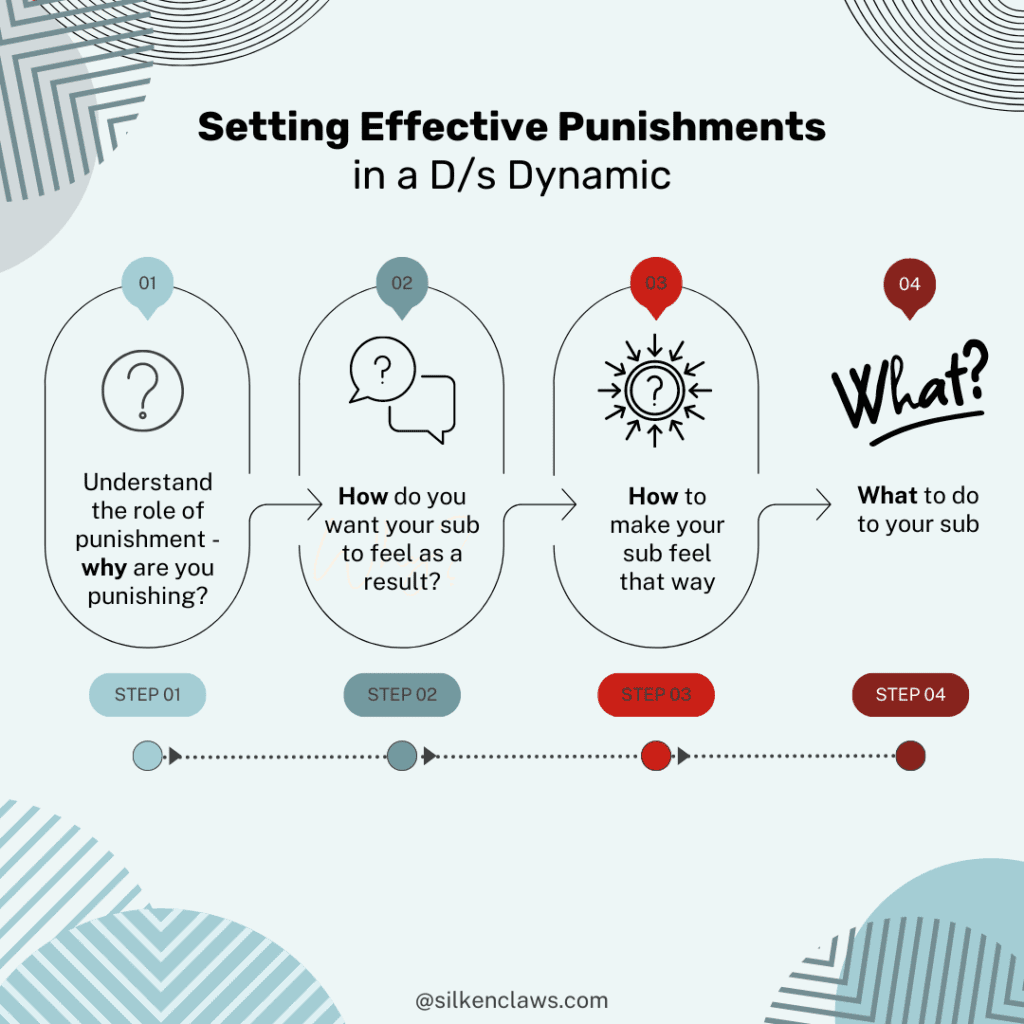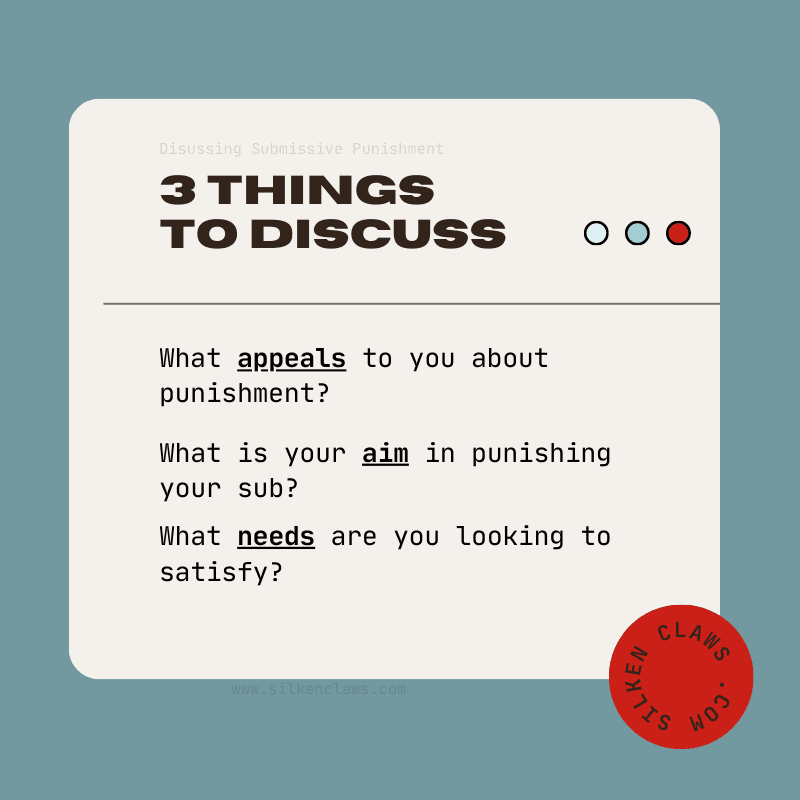
Welcome to my comprehensive guide on how to punish a sub effectively.
And when I say comprehensive, oh boy, do I mean it. This guide to punishments for subs is based on my years of experience, reading, research and community discussions, as well as a lot of trial and error in my 24/7 TPE dynamic. It covers everything you need to know to design and implement effective submissive punishment within a D/s dynamic.
Do excuse the length, but I wanted to be as thorough as possible. I have done my best to make it navigable – you will find an index below and the guide is split up into six sections.
Before diving in, just a quick word on why I wrote this. There are some great resources on how to punish a sub out there. The thing is, they are mostly in books and buried in Reddit threads.
But when it comes to online resources, most of what you find when you search for ‘punishments for subs’ or ‘punishment sub’ or the usual truncated Google nonsense are listicles of sexytime funishment ideas. Which is not particularly helpful if you’re after advice on how to implement ‘real’ punishments as part of a real life power exchange dynamic.
In fact, I found very little out there addressing the communication, self-reflection, and emotional processing required to set and develop effective punishments for subs. So, I wrote this guide to put a better resource out there. Hopefully, you find it helpful.
Let’s dive in.
Section 1: Understanding Punishment in D/s Relationships
Are you actually looking to punish your sub?
Punishment is as often fetishised and fantasied about as it is misunderstood. So, first things first, make sure it’s punishment that you’re really after.
Punishing a sub doesn’t necessarily mean hurting them
If you think punishment means a good thorough beating, well, say hello to scores of masochists out there. Want someone to write out lines or do your laundry in a head-to-toe scuba suit? There’s someone out there for whom that sounds like the perfect Saturday.
So, if punishment isn’t about pain, what is it about?
Well, ‘punishment’ really just refers to a consequence for undesirable behaviour. So, whether something is a punishment is just defined by the dominant’s intention to correct behaviour. And from the submissive’s side, what counts as punishment is entirely subjective – whether someone *feels* punished is a very personal and intangible thing.
That is to say, punishment, just like reward, beauty, and the optimal shade of brown for toast, is entirely in the eye of the beholder.
Is punishment the same thing as discipline?
Discipline refers to the practice of teaching a submissive to obey a set of rules and display the desired standard of behaviour. Punishment is a means of correcting undesirable behaviour.
Don’t want to correct your sub? You’re probably after ‘funishment’
‘Funishment’ refers to using the narrative of punishment for mutual pleasure. It’s perfectly fine if you’re not into the real thing, or want to play around with both – just make sure you and your partner are on the same page about what you’re doing.
What is an effective punishment for subs?
‘Effective’ broadly means something which is successful in producing a desired or intended result. So, if you want to punish effectively, you need to figure out what your intended result actually is.
That is to say, what is punishing a sub intended to accomplish?
This might seem like a question with one answer. But in reality, the role of submissive punishment in your dynamic will be somewhat nuanced and personal to you.
Punishment can play a variety of roles in a dynamic, so have a think about which might apply to you:
Behaviour modification: this is perhaps the most common and straightforward role of punishment – to serve as a deterrent to a particular behaviour, right? D/s dynamics generally have some kind of rules. Punishments are the consequences for breaking them – a means of making sure a sub is appropriately disincentivised from breaking a rule again.
Note that punishment generally isn’t about ‘training’ someone in an operant conditioning sense – rather, it’s about targeting underlying motivation, decision-making, and desire. But that’s a very specific point, which I will cover in an upcoming post. I do cover some of the rationale in this post on maintenance spanking, if anyone is curious.
Accountability: D/s rules, particularly in 24/7 lifestyle D/s dynamics, often aim to address more than just honorifics and orgasms. Some rules are frequently designed to target the submissive’s personal development or focus on fostering good habits. Punishments therefore can help keep a submissive on track through keeping them accountable.
Enforcing the dynamic: punishments can also be significant in cementing the reality of a power exchange dynamic – adding a stick to the carrot. Rules can get omitted or lost in the general chaos of life in a 24/7 dynamic. Punishments can be a great way to give a sub that little extra incentive to keep to the dynamic.
Atonement / closure: submissives are often driven by the need to please and knowing they displeased their dominant can be difficult to put to bed. Punishment can offer closure – a clear, easy means of atoning for whatever it is, allowing them to move on. This can
That list is by no means exhaustive, but I hope it gives you an idea as to how varied and complex the role of punishment in a dynamic can be.
Why is understanding the role of punishment important?
Well, to figure out what to actually do punish your sub, you need to figure out how to make them feel the way you want them to feel. And to figure out how you want them to feel, you need to know why you’re doing what you’re doing.

Hopefully, you’re with me so far.
What punishment ISN’T for
Right, before I get into the how and the what of submissive punishment, I want to cover why nots. That is, what punishment definitely isn’t for.
Punishment is not a way to address your sub…
- having a reckless disregard for your feelings;
- failing to respect your boundaries;
- being objectively insulting or rude to you;
- persistently and clearly not listening to what you have said;
- persistently not following clearly agreed rules / aspects of the dynamic, despite repeated conversations on the topic;
… and so on.
In short, punishment will not ‘fix’ someone being a poor partner.
While reading this guide, please do keep in mind that power exchange dynamics are based on mutual effort. What that effort looks like may vary depending on which side of the slash you’re on, but at the end of the day (and I cannot stress this enough), you cannot train a relationship partner to treat you better through D/s. If they are not going to put in effort into your relationship of their own accord, you can’t make them.
Don’t try. It won’t go well.
Equally, on the other side of the slash, a submissive should not be punished for:
- voicing feelings or concerns;
- stating a boundary or a limit; or
- providing more information to their dominant (eg explaining why they practically cannot do something they have just asked).
Punishment is a great tool, but as most great tools, it can do a lot of damage in the wrong hands. If you’re in a dynamic with any of the above, you should, at the very least, take a good, long look at your relationship and strongly consider whether it might be abusive.
These lists are by no means exhaustive, but it should give you an idea of the kind of thing to avoid.
Now, on to the practical stuff.
Section 2: Communication
While there are lots of comprehensive lists out there, I would strongly recommend you put your phone away and start with your partner instead. (Just…errr you know, not right this second. Finish reading this first, obviously.)
The phrase ‘communicate with your partner’ gets chucked around with all the reckless abandon of a three-year-old with a bucket of paint when talking about D/s in general. And of course, you absolutely should communicate with your partner. But a lot less, if anything at all, is said about how to actually do the communicating.
So, here’s what in my experience helps in having a clear conversation around punishment:
- Have a starting point
- Be clear on the distinction between punishments vs funishments
- Use disclaimers
- Prepare a list of talking points to cover
Have a starting point
Have a look at the list of roles of punishment above – if you’re thinking about punishment, probably at least one of the points resonates with you. That’s a good place to start a discussion. Perhaps you have some other ideas or previous experiences – the important point is, have something a bit more specific to start the conversation rather than just the vague concept of ‘punishment’.
Have a good think about it. I am highly biased, in that writing is very much my cup of tea, but I would recommend writing that thinking down. Just throw some words at a page and see what comes out – it will help you get a clearer picture of what’s in your head.
This, by the way, applies equally to subs as it does to doms. Being submissive doesn’t mean being passive – coming to your dominant with some ideas about what you think punishment means for you is a great example of how you can be proactive.
Make sure you’re on the same page – funishment and punishment are separate concepts!
Before you delve into a conversation with your partner, make sure you’re talking about the same concept! The distinction between funishment and punishment is a common cause of misunderstanding, so make sure you are both on the same page.
Use ‘disclaimers’ to help brainstorm
My sub and I use what we call ‘disclaimers’ – a few sentences to let the other person know the situation and to pre-empt misunderstanding. This is very useful in a variety of situations, but particularly where we are talking about something we are just coming to explore.
If you’re not sure what you want, or how you feel about it, that’s okay! Just let your partner know. If you’re not clear on what you want, chances are the way you’re expressing your ideas isn’t clear either. That leaves a lot of room for misinterpretation. Saying something like ‘I’m not sure what I want, so if you could you let me talk through my thoughts and give me the benefit of the doubt if something sounds odd / weird / etc’ can prevent jumping to conclusions and foster clear and open communication.
Talking points to cover around submissive punishment
At this stage, don’t worry about the what and the how of punishment. Just focus on the why.
A lot of people rush into the kinky aesthetic, grab the nearest listicle and then wonder why it’s not working. I know, because… Quite a few of those people have ended up in my inbox over the years.
Take the time to understand what is driving you and your partner – trust me, it will save you a lot of time and agro down the line.
Bear in mind, these conversations don’t have to be ‘serious’. You can integrate them into space. There’s no reason you can’t tie your sub up and have a chat during, or even integrate it into something more complex. As long as both parties feel comfortable expressing themselves fully, there’s no one right way.
When you have the talk with your partner (or probably several conversations, if your life or brain are anywhere near as chaotic as mine), consider the following:

What is appealing about punishment?
Ideally, you will already have some idea of why do you want to add punishment to the dynamic, but really delve into it. What appeals to you about the idea? What appeals to your partner? Do you have previous experiences with punishment? What is the idea of punishment you have in your head and why? It really helps to understand what pre-conceptions you are both coming to this with.
What is your aim in punishing your sub?
What is the aim of punishment for both of you? Look at the list above. Do you want closure? Structure? To ensure that the behaviour won’t happen again? Pin down what practical, emotional or psychological needs or wants you are looking to satisfy.
Understand the feelings at play and the emotional / psychological needs and wants
How do you want to feel while you are punishing / being punished? How do you want your partner to feel? It may sound silly to say ‘I want you to feel punished’ or something similar, but it can go a long way to getting what you want – the person best placed to guide you in what will be most effective for your partner will be your partner.
Section 3: Practical Points to Consider in Submissive Punishment
So, if you’ve gotten through all of that, you can set about starting to design an effective protocol for your dynamic – that is, what punishment will look like. I would strongly suggest reading my post on how to set protocol. I have just covered the points which specifically relate to punishment in this guide.
Why have protocol?
Why bother with protocol? Well, protocol is about creating easy, sustainable ways of connecting with your dynamic. Protocol just means putting the effort in up front to create an easy, thought-out way of doing something, which helps both of you connect with the right headspace, so that you don’t have to think about it that amidst the chaos of everyday life.
How to set rules for subs
Keep it simple
When you are setting protocol, pick a few rules to start with. It’s easier to add to the list as you settle into your punishment protocol. You don’t want to overwhelm yourself and your sub with a long list of rules and associated punishments neither of you will remember. Don’t set yourself up to fail.
Make it specific
Make the rules for your sub specific. While ‘you have to do everything I say’ might seem like it covers your bases, the more specific the rule, the clearer you will both be on what the expected behaviour is. That will make it a lot easier to know when your sub’s behaviour has fallen short of the agreed standard.
Make the offence clear
Every time a rule is broken, it should be crystal clear what the consequence was. Ensure both of you understand which rules can result in which specific punishments.
Think about how to keep the reason at the forefront of their mind. Would you like to have your submissive recite the rule as they are punished? Write about what they did wrong? Find a way to connect the offence with the consequence. The clearer the connection, the more likely the punished submissive will ‘learn their lesson’.
Handling emotions around punishment
Quite a few guides out there basically just say ‘never punish in anger’ and leave it at that. The thing is, anger isn’t the only, or even most common, emotion you are likely to deal with. Remember, the punishment you design should fit into the day to day of your life, so it needs to account for all the ups and downs. The great washing machine of life.
Effective punishment relies on understanding the thoughts and feelings which led to the misbehaviour in the first place. So, consider how you’re going to deal with underlying emotions when designing your punishment protocol.
Remember and have a think about how disagreement or dealing with emotion looks in your relationship – do you usually need space? Does your partner? Do you need to talk everything through before the emotions can be resolved?
Especially if you have no previous experience with a 24/7 dynamic, do bear in mind, effective change is always incremental – the way your relationship looks is the product of needs, reactions and habits. It’s not something you can fundamentally change overnight!
To create a sustainable protocol, you need to think about how emotions work ‘normally’ in your relationship, then work out how D/s can fit around that. Even if you want things to work differently, you need to start by acknowledging how they work now and working from there.
Think about timing and promptness
Think about when you want the punishment to occur relative to the offense. A lot of guides out here will say ‘it’s important to punish promptly’, but that’s not a universal truth. Understand the rationale for punishment in your dynamic, your sub’s needs and adapt to what is feasible.
For example, if part of the rationale behind punishment is to atone and put an end to the issue, sooner is better than later. But if you’re going for deterrence, maybe giving your sub a week or two to contemplate the impending consequences is a good idea.
So, want your sub to stop thinking about it and move on? Punish quickly. Want to make a point? Punish slowly. Bear in mind the practical constraints of time in picking out a punishment. If you want to punish as soon as the need arises, design your punishment to be quick and simple. If you’re going to go through a list of infractions once a week on Saturdays, pull out all the stops and go to town on a high protocol filled ritual. Just make sure you design something which is going to be practically workable.
Should the punishment fit the crime?
Punishment does not have to be fair or proportional.
I know we have generally been given the idea that the punishment should fit the crime, but in this case, it really doesn’t have to. There are plenty of emotional masochists out there who thrive on unfairness, harshness, and cruelty.
That said, there are also plenty of subs who would feel hurt and ill treated if the punishment was disproportionately harsh. So, consider what would fit the needs of your submissive better – proportional or non-proportional punishment.
The power of ritualised protocol
A ritual is a powerful thing – it’s part of the magic of high protocol. Repeating a protocol leads to habit formation. Notably, this includes emotional habits – you know how you feel every time you watch that one film that makes you cry? Or a song? Somewhere in your head, the emotional state and cue are connected.
The same applies to punishment. If every time your sub has to kneel in the same position, make the same preparations, and is subjected to the same punishment, they will form an association with those actions. This can serve to make punishment more more ‘scary’ and can give you another tool in your arsenal. But hey, that’s written from a sadist’s perspective. More significantly, having an element of ritual will help both of you connect with the right headspace and the dynamic.
That said, protocol doesn’t mean you have to make punishment the same every time. The protocol you design can be a looser framework, which allows you to dole out more flexible punishments. Even if you are opposed to ritual, I would still take the time to develop protocol – it really is key to a sustainable 24/7 dynamic!
Section 4: Health and Safety – addressing practical and emotional risks of punishment
Aftercare and limits
These two points are stressed a lot in the kink community for good reason. But if you’re past the kink 101 stage, they can get a bit tiring to read about. So, if you’re experienced or really, if you’ve been around the kink community for more than five minutes, look, I’m sorry. I know you know. But I have to cover this just in case anyone reading this doesn’t.
Punishment is not a reason to skip aftercare or cross previously agreed limits.
That said, do note that there is no one right way of doing aftercare. Not everyone goes for the hugs, chocolate, and blankets, and that’s okay. I know people who are happiest stuck in a cage for a few hours. It’s about what works best for you personally. As long as the sub feels their emotional needs have been taken care of in whatever form works best for them, it’s all golden.
The dominant side of punishment
A lot is said out there about how to keep subs safe, but there’s not so much about how it can affect those of the left side of the slash, so I just wanted to cover two key points.
Discipline does involve emotional labour
This is an aspect of punishment people rarely consider or discuss. I suppose because, outside of kink, the person doling out the punishment doesn’t assume that role voluntarily.
But punishing someone does require mental, emotional and, perhaps, physical effort. You need the time and capacity to think about it. Which is of course part of the responsibility which comes from being dominant in a lifestyle sense. But it is important to acknowledge that the dominant is putting in effort into the dynamic in punishing a sub, as counter-intuitive as that may seem. They are doing what they should be doing and it’s important both parties keep that in mind, especially when setting out to incorporate a dynamic into everyday life.
Dealing with guilt
It’s not uncommon for dominants to experience some element of guilt during or after punishing their submissive. As I said above, it’s important to remember that punishment is a negotiated part of the dynamic. It serves to maintain it and the connection the dynamic is based on. You haven’t done anything wrong!
Remind yourself of the reasons behind integrating punishment into your dynamic and its role within your D/s dynamic. (See, the ‘why’ of punishment coming in useful here again. This is also why it helps to have some of these things written down).
If you find yourself really struggling with guilt or uncertainty, well. Please save yourself a Reddit post and just go and talk to your partner. Chances are they will be happy to reassure you and, at the end of the day, it’s the only way that your feelings will actually be resolved.
Section 5: Good Punishments for Subs
Types of submissive punishment
Right, now all of that is out of the way, we can talk about the what.
When choosing the right type of punishment for your dynamic, it’s obviously important to consider what is right for your submissive. But don’t forget to think about what is right for you. As I said above, what punishing a sub feels like can really vary for a dominant. Consider how something makes you feel as well as how it makes your sub feel.
That is to say, if caning would work ideally for your submissive, but you hate the idea of punishing your sub that way because you hate caning, or worse, love caning and don’t want to bring it into this context, don’t feel obligated. To fulfill your role in providing discipline, you need to connect with the right headspace and at the end of the day, making it a ‘dom punishment’ is unlikely to help you get there.
There are varying schools of thought on whether punishment should be enjoyable for a dominant. I think that is largely a matter of individual taste. Personally, I rarely enjoy punishment, because I am not exactly in an frame of mind to enjoy things when my sub has disappointed me in whatever way. But this is just one of those points on which mileage can vary.
Add something unpleasant
Pain
Punishment is supposed to be unpleasant to some degree and pain is one of the most obvious kinds of unpleasant there is.
Corporal punishment / impact play
If you’re going to employ impact play as a submissive punishment, I would suggest differentiating what is punishment and what isn’t.
Most doms own at least one piece of impact play equipment they absolutely adore and their sub is not too keen on. If you’re in that club, that paddle or cane or flick stick would be an excellent candidate for a designated punishment tool. Having a tool especially for punishment can be good practice to really clarify what is and isn’t punishment, especially if you engage in both impact play and funishment.
Chores
Something unpleasant doesn’t have to be kink related. Set your sub doing a chore which is particularly arduous or annoying. Have them meticulously weed the garden, scrub the bathroom grout, or vacuum under every single piece of furniture you own.
If you feel like you don’t have a chore which is arduous enough for your liking, by all means channel inner ugly step-sister and come up with an entirely new pointless chore – separating ash from poppy seeds, say. Or just limit the tools they can use or the position they have to do an actually functional chore in. Make it as oddly specific as you like. Say, only allow them to weed the garden using chopsticks or use a toothbrush to scrub the grout.
Honestly, my best advice here is – let your imagination go to town and don’t be afraid to be weird. Let’s face it, if you’re reading this guide, you’ve joined the club of people who passed the ‘weird’ milestone several miles back. You have a human who’s on board with you being your kinky self, so be as marvelously and uniquely you as you can be.
Old fashioned domestic punishments
You can always wheel out the old classics:
- Corner time / time-out
- Pressing coins to wall with fingers / nose
- Washing their mouth out with soap
- Kneeling on rice (note: this one isn’t for the faint of heart!)
There’s a reason these have been kicking about for such a long time – namely, they’re easy to inflict and really quite unpleasant.
Ordeals
Subject your sub to a period of uncomfortable confinement, predicament bondage, or sensory deprivation. Generally, this has the added benefit of being relatively low effort from the dominant perspective (other than a common sense level of monitoring).
Deprivation
You can take away a privilege that they have within your dynamic, or just something they like in general. It depends on the extent of power exchange you have.
For example, you can limit screen time, sweets, or whether they’re allowed in the same bed as you, as applicable. Basically, find a thing they like, but don’t need, and limit it to a fixed amount of time.
A good stern talking to
Not all punishment has to involve something physical. It might sound silly, but genuinely there are situations when just giving your sub a decent telling off might do the trick. And when I say that, I don’t mean random complaining or gripes that can come up in the context of every day life. I mean put them in a position which reminds them of their place (say, naked and on their knees) and take them through an itemised lecture as to why and how they have disappointed you, a la sitting in a headteacher’s office.
Genuinely, there are some subs out there who would take literally any other punishment from the list than this, so it’s really worth a mention.
Note on sexual punishments
While some people opt for sexual punishments, I personally don’t think they are a good idea for two main reasons:
i. my dynamic involves a component of free use. So, I wouldn’t want to restrict my access to my sub or my ability to have him do what I like; and
ii. I don’t like mixing sex in with something which is supposed to be unpleasant, because it muddies the water. Orgasm denial, chastity, and edging are all kinks in their own right, so it’s difficult to untangle to what degree a sub is genuinely enjoying the ‘punishment’, to what degree the punishment is satisfy mental / emotional masochism, and / or to what degree the punishment is actually a punishment.
That said, some people are partial to them. So, if you think it will work for you, go for it. I would just keep the above two points in mind to make sure that you don’t unwittingly veer into funishment territory. As it seems to be a popular topic, I will cover it in a separate post soon and just link to here, as I think it’s something slightly different.
Option to consider: have your sub set their own punishment
It is also worth considering having your sub come up with an appropriate punishment themselves. Just asking them to come up with ‘a punishment’ might be a bit too vague though, so I would recommend more of a directed approach. Give your submissive a type of punishment to brainstorm around, or come up with a list they will be forced to chose from. Or vice versa, have them come up with a list of punishments for you to chose from.
This can will help give you an idea of what your partner is thinking and can also form a part of the punishment itself. A dominant friend of mine has been known to employ making a list of punishments as a punishment in itself, which then helps him figure out future punishments. So, all in all, this can be a helpful exercise.
Punishments to avoid
I’m not going to say you should never use any of the following. What I will say is that the below are inadvisable as punishments for (at least) most people.
The silent treatment
Personally, I find the silent treatment to be just plain childish. But beyond that, it’s just poor communication. In any relationship and especially a power exchange one, if your partner did something wrong, just tell them. Equally, if you need space, tell your partner that. There’s a big difference between not talking to someone for nebulous reasons and explicitly taking time away to process your thoughts and feelings.
Withdrawal of dominance
Withdrawal of dominance should not be a punishment. Power exchange dynamics depend on maintaining a strong connection and, really, punishing a sub is about reaffirming that dynamic. Withdrawing dominance is in fact likely to have the exact opposite effect.
That said, it is perfectly valid to step back from the dynamic when you don’t feel as if the effort you put in is reciprocated. However, that is distinct from punishment and should be clearly communicated to your partner. Don’t just arbitrarily and suddenly step back from your dynamic and assume your partner will telepathically know why!
So, how to punish a sub?
To sum it all up…
…here’s a step-by-step of how to design effective submissive punishment.
- Understand what role punishment can play in a dynamic
- Talk to your partner and figure out what punishment means to you
- Think about the practical considerations in setting protocol for punishment
- Make sure you are both aware of the risks and best practice
- Decide what the punishment will consist of
- Put it all together to create a life-proof protocol for punishment
That has taken light years to write, so if you find it helpful, do let me know! Equally, if there’s anything I’ve missed that you think should be a part of this resource, tell me – I intend to expand and revise this guide over time, so suggestions are by all means welcome.
Last Updated: 16 March 2025





PLJ says:
I love your stuff. This should be a book. You write with such consistent authority, explaining, enriching. You have a gift. Plus the graphics are great.
My own relationship to punishment is very disconnected from this post. I don’t know if that is the result of playing out my own D/s dynamic in the rarefied environment of the pro-client world, or is just me. But I don’t need to be punished.
If I do something wrong, which is inevitable, so rather, if I displease somehow, disappoint, I feel what I can only describe as psychic pain. In this context, atonement is the one avenue I can identify with, as it would release me from what can be months of self-flagellation when I feel that I have failed or let her down, or worse, disrespected.
I know that there are brats out there, and I am living through a personal moment of my own brattiness, something which has never surfaced before, and which I have scurried off to therapy to delve into, but I am not a conscious brat ever. My partners have never been into protocol, and perhaps I am not either (though I tend to be into what she’s into), though I do seek to respond to very delicate signals she sends.
It’s interesting, for I would never choose to be hit, or whipped, as I am not a fan of pain. But what I am a fan of, is when impact play becomes an avenue for devotion, to show that I will lay myself down and take whatever to be pleasing.
To me, the most powerful punishment of all is to be ignored, denied the presence of, to be excluded, shut out, not touched. I shudder to think of what such a punishment would do to me.
As a human, I am not capable of not failing, not making mistakes. But as a submissive, as a slave, my pleasure stems from her pleasure. And it is manifest in all parts of my life. I recently took a friend to Venice, and it mattered to me that she had a wonderful time, and one point she wasn’t, and she expressed that. She’s a very good friend, and pleasing her and taking care of her is just as important as it would be for my Queen..she knows it, cultivates it, appreciates it. When I am good, and she is really pleased, she calls me “slave”. In other words, we understand each other. But when she was unhappy, and it was trivial, I ended up crying.
It was good, because it allowed us to come back in sync. And what is the purpose of submission if not to sync with the domme? At her pleasure, towards her energy, to honour, support, and serve? And when we get to that place, emotionally, spiritually, with the right partner, then we are in the zone. And in that zone, the most powerful punishment of all is failing.
And in this sense, having a chance to atone, in whatever way, is the healing–and if punishment isn’t about healing, then it is not correctly placed.
Thank you for continuing to be an inspiring voice.
Miss Rosalie says:
Thank you for your kind words!
Atonement can be such an important role of punishment – it can put an end to a lot of overthinking and rumination for a sub, in a quick and efficient manner, and free up emotional capacity for both sides.
I completely agree that the purpose of submission is to reconnect with the dynamic and align the ‘energy’ (although I must admit, I am not so knowledgeable on those kinds of things as you are haha). But I think, the key point is that it’s about that connection and mutual understanding.
And you’re absolutely right, if punishment doesn’t lead to growth and development within the dynamic, then it may not be from the right place!
I am glad you find my content inspiring. Thanks for sharing your experiences – it’s always enlightening to hear diverse perspectives on D/s dynamics.
thebarefootsub says:
As always, I love reading your thoughts on D/s. Punishment is something I’ve only received twice, both with my former Dominant. The first was a play-scene storyline. The second I had to write my own suggestions for punishment, and then he combined them all. Cruelty! But of my own making.
My new D has a different approach to kink, discipline and life in general. It’s interesting finding my feet with him. And I know that he will be using punishment/funishment/correction in his own way.
Miss Rosalie says:
Thanks! And thanks for sharing your experiences! Having a sub write out their own punishment is a particular kind of mindfuck and works a treat. It’s like getting a sneak peek into a sub’s desires / fears / limits, and then using that to keep them on their toes. I will pop it into the guide.
It’s fascinating how different dominants can approach kink, discipline, and life in their own ways. How does your current dom’s approach differ, if you don’t mind sharing?
thebarefootsub says:
Apologies for the delay. I read your response, went off to investigate punishment and it’s not really happened with me. I’ve had one extra cane welt, for swearing once during a cold, hard caning. But consistency has been missing. Though I know he uses punishment with his two slaves, but they suffer pain rather than rejoice in it so I think correcting misdemeanours (which I’ve never needed before except for two times with S) may be a bit of a head scratcher. Giving me something I crave to make me behave better isn’t going to work.
I guess it is a different headspace for us both? Or the wrong dynamic for us. #TeethingProblems perhaps.
Oz Bigdownunder says:
This is a really valuable resource. Thank you for sharing.
Miss Rosalie says:
Thanks! A lot of work went into it, so it’s really lovely to hear that.
attackmanatee says:
My wife and I just started our dom/sub relationship together and this really helped me understand some things that i need to make clear between us, as well as giving me some fun ideas. Thank you for the help